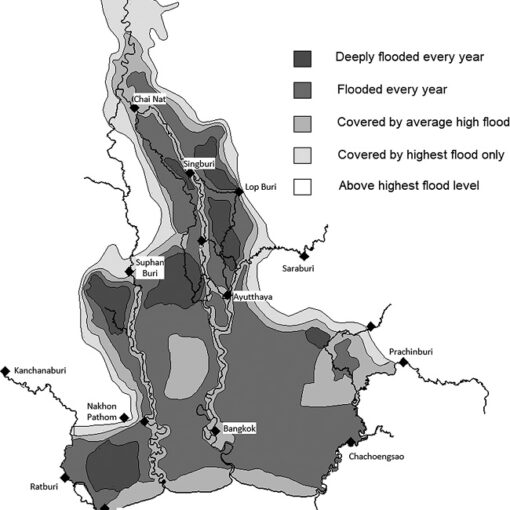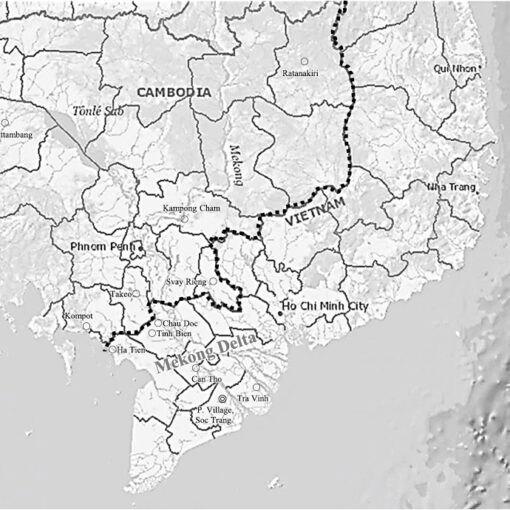Contents>> Vol. 10, No. 1
The Collapse of British Rule in Burma: The Civilian Evacuation and Independence
Michael D. Leigh
London: Bloomsbury Academic, 2018.
In his previous work, The Evacuation of Civilians from Burma, Michael D. Leigh covered a time in Burma when the myth of British imperial invincibility was shattered by rapid Japanese invasions of Southeast Asia. With the scope of that work ending in May 1942, The Collapse of British Rule in Burma continues the narrative and provides a welcome contribution to the scholarship covering the Second World War in Burma, often referred to as “Britain’s forgotten war.” Despite this book continuing the author’s previous work, it should be emphasized that it is a stand-alone work and fills a gap in scholarship by presenting an account of the collapse of British rule, with a focus on the civilian perspective. The dominant impression given is one of embarrassingly poor planning and governance on the part of the British authorities, which contrasts with outstanding displays of character and spirit in the face of adversity from many of those rushing to flee Burma in the hope of finding solace and security in India. Indeed, the official handling of this situation was so humiliating that, when combined with the demythologizing of British superiority, it was impossible for those administrators that did return to restore British rule following the Japanese surrender or to hope for anything beyond a rushed but negotiated exit.
However, the appeal of this work is not simply that it covers an oft-overlooked area but also that the author presents an incredibly detailed combination of academic assessment and personal accounts. Those rushing to evacuate were a strange combination of British expatriates, Anglo-Indians, and a cross-section of the Indian community ranging from those engaged in commerce to those working as soldiers, as servants, and in similar professions. Leigh manages to demonstrate how no two experiences were quite the same, with panic and desperation permeating all accounts. A rapid advance by the Japanese followed an initial surprise invasion, and within four months of the initial crossing from Thailand the entirety of Burma was within Japan’s grasp. Leigh attributes this humiliating collapse of British defenses to repeated underestimations of Japanese military capability, a mistake that the indigenous independence movement did not make, working with the Japanese before, during, and after the invasion. Accompanying this is a potted history of British expansion and Burmese nationalism, which provides a welcome context for those who are approaching this from a non-Burma focused background. This is matched by a general contextualization of the Second World War in Southeast Asia for those with less of a grounding in military history. With the context thus established and the focus of the book firmly on the civilian experience, it is perhaps unsurprising that the role of the Japanese forces throughout the rest of the book is comparable to beaters on a shoot, flushing and driving civilians onward into rushed escapes, via direct actions such as bombing and strafing convoys and settlements, but also through the sheer power of their psychological role as an existential threat. And so, instead of the Japanese, the main enemy in the majority of the accounts of evacuation is nature, whether the dusty dry season bringing dehydration and heat exhaustion or the rains and humidity leading to sores, infections, and malaria.
The main body of the work focuses on three evacuation routes out of Burma, using individuals and their experiences to illustrate the often brutal and punishing reality that was deadly for so many that attempted it. First was the Chindwin Valley, viewed as the quickest, safest, and easiest; this was used by Europeans who had left their evacuation planning until too late but set forth, in some cases taking their cars as far as possible and in others using steamships for the majority of the journey. Another group selected for specific attention is a group of wives and children of Bombay Burmah Trading Company (BBTC) managers, with Leigh describing their relatively relaxed start with elephants, a cook, and good-quality produce that soon takes a turn for the worse with the coolies starting to die from cholera and stays in an “unpleasant refugee camp . . . on hard bamboo beds in huts” (p. 47). However, this hardship seems short-lived, and the families’ privilege and station ensure that they are well looked after by the BBTC. This contrasts with the experience of the poorer classes who struggled through without the aid of elephants, coolies, or reliance on their husband’s position in society. As in most terrible situations, humanity is often surprisingly resourceful, with key examples of selflessness. For the Chindwin Valley, the standout figure is Major William McAdam, who acted to keep the aforementioned cholera (and other diseases) down to a minimum, refusing to panic even as hundreds were dying, and personally inoculating thousands of evacuees, acting as an inspiration for those around him. In terms of actual infrastructure, Leigh pays tribute to the nameless laborers and porters who contributed in their own way to the saving of thousands of lives by either working on the roads or helping with luggage, etc.
The next route is the Hukawng Valley, where during the rainy season the amount of mud involved leads to a comparison with Passchendaele (p. 80). This follows the Chindwin route being closed and the governor fleeing Burma. The final airfields are now destroyed by Japanese bombing, and so the desperation to leave has resulted in much riskier routes being taken. Diseases like malaria and dysentery are rife, leading to death being so common that “it was briefly mourned by near relatives but ignored by the passing crowd” (p. 61), with decomposing bodies being felt under the feet of those trekking through the mud, past huts filled with bodies. On this route, it is Cornelius North’s conduct that stands out. He stayed at his post after his superiors fled to India and “prevented a tragedy from becoming a wholesale disaster” (p. 60). However, emotions ran high, and despite other accounts speaking of “tolerance, fairness and generosity to people of all race” (p. 84), one account accuses North of favoritism, condemning the conditions of the camp. The government and colonial administration are, at most points, notable for their absence. Instead, we have figures like North standing out, and organizations like the Indian Tea Association, which provided food, porters, elephants, camps, medicine, and other support, ultimately saving many lives. The association played such a key role that Leigh gives it its own chapter, detailing how its engineers and tea pickers switched from their usual roles to work on the front line of evacuation, ultimately taking up the mantle of administration and care that had been hastily abandoned by the civil servants meant to be running the country.
The final and most severe route was the Chaukan Pass, which was so hazardous that the commander in neighboring Assam urged the Burma government to prevent anyone from using it. As mentioned numerous times earlier, the Burma government had collapsed and certainly was in “no position to be preventing anyone from doing anything” (p. 97). That said, this route was notoriously hazardous and why anyone used it is viewed as a bit of a mystery by Leigh, who links a handful of theories, such as a rejection of “diktats delivered by pen pushers” (p. 99). With the two previous routes being in such a state they claimed thousands of lives and this route being more precarious, it is remarkable that those using it survived at all. Despite subsequent spinning of the terrible situation as an “adventure yarn” with “high-ranking colonial officials and faithful native bearers being rescued from the jaws of death” (p. 99), from Leigh’s perspective it seems that it was more a case of disproportionate resources being spent on ensuring any of these officials survived, with much of the success attributable to porters, “menials,” and soldiers who remain nameless. For those who survived the evacuation via any of the above routes, the impact of the horrors they experienced seems clear and accompanied them as they were settled across India. Once again Leigh’s attention to individual and personal stories stands out here, with rather dull and depressing experiences juxtaposed with the successes of those who saw their escape and their post-escape time in British India as a chance to network and further their professional career.
A combination of the suddenness of the Japanese surrender and the focus on the evacuees rather than the ongoing situation in Burma, the return to Burma—of both its former inhabitants and British rule—seems rather abrupt, which is probably an accurate representation and adds further to the indictment of the Burma government as incompetent. The author devotes the final few chapters to explaining Burma’s progress toward independence, something that helps bring the study to its natural conclusion, though it is better covered elsewhere. Ultimately the argument advanced by Leigh is that the poor handling of the evacuation demonstrated the general ineptitude of the colonial administration and further underlined its unsuitability for further rule over Burma, in the eyes of both London and the Burmese who were now clamoring for independence. Combined with the ascendancy of the US as the key world power, the resulting change in opinion toward colonialism, and the poor experiences of the British in enforcing colonial rule on behalf of allies in Vietnam and Indonesia, Burma is viewed as more a liability than an asset.
Of the 350,000 evacuees, Leigh estimates that more than 90 percent were Indians, and so it is somewhat surprising to see their experiences relatively absent from this study. Whether this is due to poor preservation and a lack of diary keeping or an inability to find sources is not clear. Indeed, an account of the experiences of Indians during this pivotal time—if possible—seems worthy of further study, given the Indians’ position of “being between a rock and a hard place” as they found themselves viewed as British lackeys by the Burmese nationalists and treated badly by their colonial overlords. That said, this volume still contributes an interesting approach to this era of British imperial history, with the reader finding a real appreciation for the nameless laborers and porters who made the large-scale escape possible. As such, this book would be of interest to those with a curiosity for military, imperial, and social history as well as Southeast Asia and Burma specialists who seek to understand the dynamics of this key period. Given the lack of resources available on the experience of evacuation from the Indian perspective, it is understandable that such a viewpoint might be lacking; but one criticism is that there are some bizarre moments of repetition in the text, with the same event being described in the same words in different chapters. This is more of an annoyance than a significant flaw as it does not impact on the argument advanced by Leigh, but sadly it lets down what is otherwise a tight and well-written book.
Thomas Edward Kingston
Renmin University of China
DOI: doi.org/10.20495/seas.10.1_175



